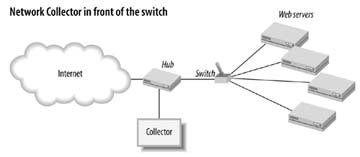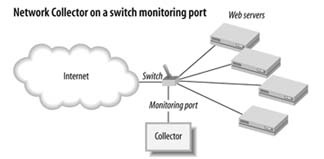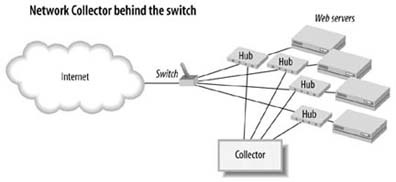Network data collectors, or “packet sniffers,” create an alternative data source that has a handful of benefits, provided that you maintain their upkeep.
Users respond not only to a site’s content, but also to its delivery, which include factors such as speed, quality, and reliability. Together, content and delivery influence what users choose to view, how long they view it, how they navigate through the site, and ultimately whether they will return. All the compelling content in the world won’t save a web site that can’t deliver it well.
Many options exist to get information about what content was served. But to get the delivery information, in order to get a complete picture of user behavior, you can turn to collecting data at the network level. This is commonly referred to as network collection (or using a sniffer, but Sniffer® is a registered trademark of Network General Corporation to describe its line of protocol analyzers, so we won’t use that term here).
Because of the design of the network layers in a computer system, the low-level details about the network packets are unavailable to the web server—this is a good thing, as it allows the web server to concentrate on serving web content. However, by the time the server sees the transaction, much of the underlying performance data is lost, or has been modified into something less useful.
For instance, a web server can log when it sent some content, but cannot know if the client actually got it, or if the client didn’t get it, how much it got before the client stopped the transaction. Using collection methods such as page tagging, you can capture more granular information about page deliveries, but cannot determine why a transaction was slow or failed. In general, application-level loggers (web logs, page tagging, server plug-ins, etc.) cannot report:
Client-initiated disconnects (for example, users hitting the stop button in mid-download)
Network problems: server retransmissions due to overloaded networks
Busy signals: requests ignored by the server due to overload
The time the server took to respond to each request
A network collector (usually just software running on off-the-shelf hardware) is a specialized packet grabber that “knows” all about web traffic. It passively watches the traffic flow across the network and keeps a record—similar to a web server log line—of what it sees. Because a network collector lives on the network, however, it can see and report what application level loggers cannot.
Imagine an observer on a freeway overpass. If the observer is fast enough, it can count all the cars that go by. If it’s really fast, it can log information like the car’s color, make, model, or number of people in each car. All this can happen without disrupting traffic flow (Figure 1-8).
Figure 1-8. Typical placement of a network data collector on a hub in front of your web architecture
From this viewpoint, a network collector can view traffic for all web servers on a particular network. One network collector can gather statistics for many web servers simultaneously, reducing the cost of manually administering logfiles on each web server.
This wealth of information becomes a great foundation on which to analyze a web site. The combination of content and delivery makes for powerful analysis. For example, what happens to the average number of pages a web surfer sees at a site when the server’s response time goes from under two seconds to over 10 seconds? Which content is most abandoned during download? What is the relationship between users’ connection speeds and page views? Is there a particular CGI program that should be tuned because it’s taking too long to run?
A network collector relies on having a machine watch the network traffic between browsers and the web server, so it must be on the network path between the two. In a shared media environment (such as a hub), the sniffer collects all the information because every port on the hub sees traffic to and from every other port on the hub.
In the more common switched environment, each port on the switch transmits only traffic that is supposed to be for the machine (the web server) plugged into that port. Putting a network collector on a switch port means that it sees only traffic for itself, and not for the web servers. This isn’t very useful!
There are several approaches you can take to allow network collectors to work in a switched environment. Each has its advantages and disadvantages.
- Get in front of the switch
In this scenario, the network collector lives “upstream” from the switch, where it can see all traffic flowing into the switch. This allows the collector to see traffic between the Internet and all the web servers (Figure 1-8). However, it does not see traffic between two web servers, since that happens through the switch. In practice, this isn’t a problem.
The big hurdle with this approach is that there is usually a high-speed point-to-point link between the router and the switch. In order for a machine to act as a network collector, it would have to tap in to the stream. Tapping into a half-duplex stream (such as a normal 100 Mbps Ethernet link) would work by connecting the router, switch, and collector to a hub where they can exchange data. This means the collector will have to process a huge amount of traffic, looking for just the web traffic, so the processor speed of the machine would have to be sized accordingly.
In very high-speed environments, the link between the router and switch could be a full-duplex link, where the link speed is effectively doubled (so traffic may be flowing between the switch and the router at 200 Mbps). Monitoring this traffic isn’t possible without specialized hardware and software.
- Configure a monitoring port
Most switches can be configured to send traffic from/to specific machines to another port. This “monitoring port” contains duplicates of the traffic, and the collector runs as if it’s plugged into a hub (Figure 1-9).
The downside to this approach is that traffic within the switch is increased. Let’s look at an example 12-port switch. Ten of the ports are running web servers. The ports are capable of 100 Mbps, but only about 40 Mbps sustained are flowing per port. Thus, the switch is passing 400 Mbps through it, which could easily be within the maximum limit of the internal backplane on the switch. If we then configured one port to be a monitoring port, all the traffic would need to be duplicated to that port. However, now the switch would be trying to put 400 Mbps onto the 100 Mbps monitoring port, which is beyond the capacity of the port.
- Put the data collector on the web server itself
If the collector can be isolated to a piece of software, and run on the web server, it can collect network-level statistics. However, this can add an additional load to the web server.
- Put a hub between the switch and the web server
This is almost the opposite of getting in front of the switch. Here the collector lives behind the switch. Rather than plugging the web server directly into the switch, plug the web server into a hub, and plug the hub into the switch port (Figure 1-10). Now you can plug the network collector into the hub. Downsides to this approach: you’re adding a hub per switch port, and the collector can only see one web server.
Generally, you’d put an SSL frontend device before the web servers. That offloads the web servers from having to manage the encrypted packets. It also allows you to put a network collector behind the SSL box and in front of the web servers, where the traffic is unencrypted.
If there is no good place to monitor all incoming and outgoing traffic due to network layout, a network collector won’t work, and you’ll forfeit delivery information. In these cases, consider using a network collector for some part of your traffic—say, a particular set of machines—in order to “spot check” some of your delivery data that’s not available though other collection mechanisms.
—Bob Page and Eric T. Peterson
Get Web Site Measurement Hacks now with the O’Reilly learning platform.
O’Reilly members experience books, live events, courses curated by job role, and more from O’Reilly and nearly 200 top publishers.




